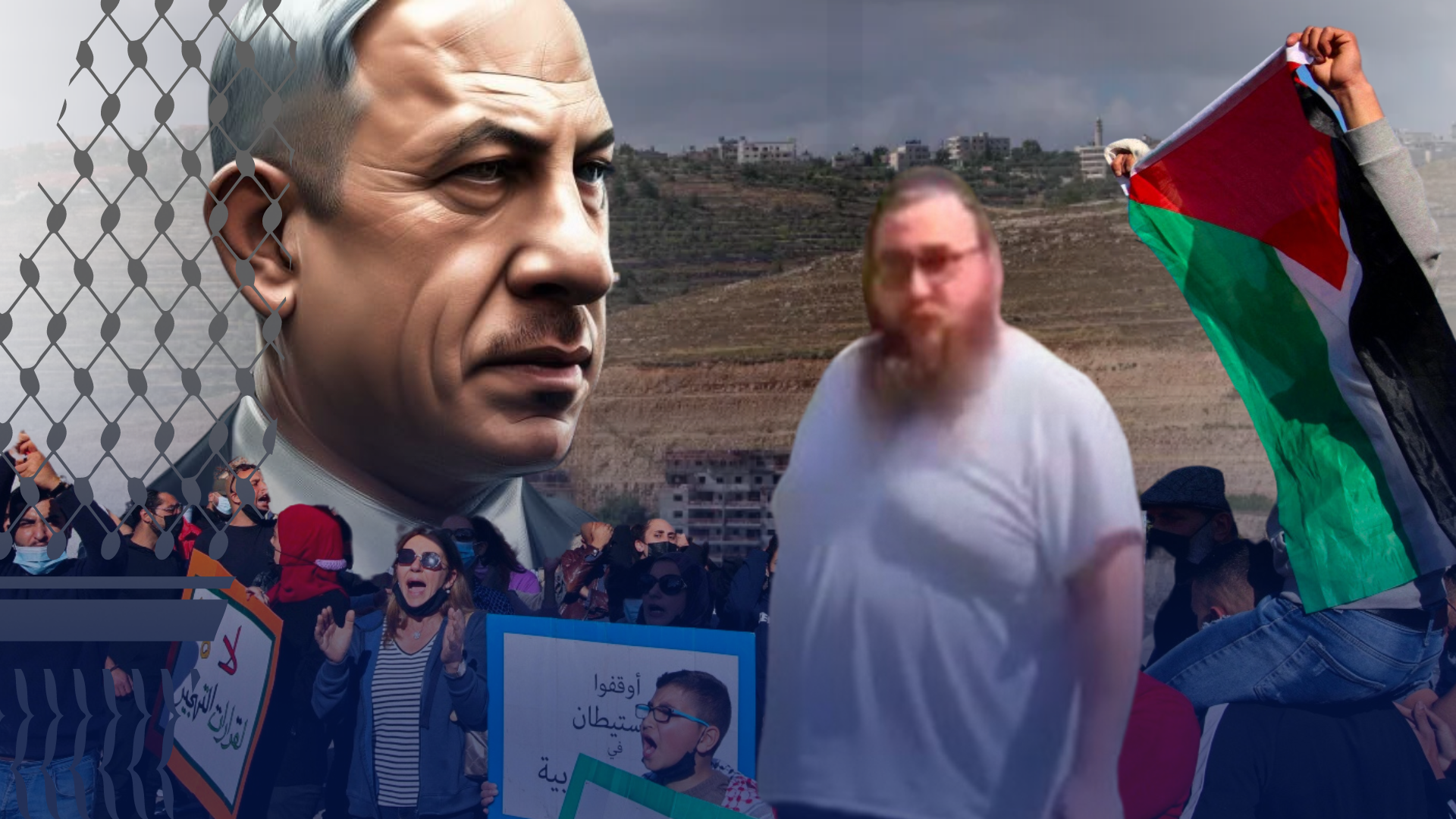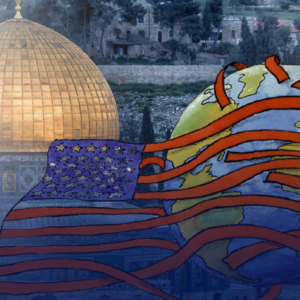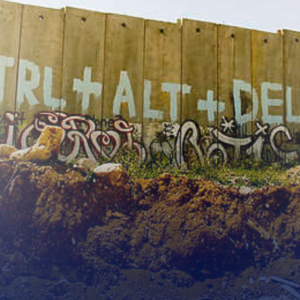PART VIII: Occupied Palestine 2007-2022: East Jerusalem

PART VIII: Occupied Palestine 2007-2022: East Jerusalem
Palestine. What was once a thriving, culturally, and religiously diverse land, now lies under the military occupation of a racist, colonial regime. In the early 1900’s, ‘Imperialism’ and ‘Zionism’ merged together in perhaps the greatest conspiracy in human history: to uproot a nation and establish a military outpost in the form of a settler-colony on the shores of West Asia, to serve the British Empire’s interests in the region.

PART VIII: Occupied Palestine 2007-2022: East Jerusalem
Palestine. What was once a thriving, culturally, and religiously diverse land, now lies under the military occupation of a racist, colonial regime. In the early 1900’s, ‘Imperialism’ and ‘Zionism’ merged together in perhaps the greatest conspiracy in human history: to uproot a nation and establish a military outpost in the form of a settler-colony on the shores of West Asia, to serve the British Empire’s interests in the region.
Written by: Nadia Hojaij and Yahia Hassani | Copy Editors: Zainabrights | Design: Fatima El-Zein
East Jerusalem
Throughout history, the land of Palestine was always referred to as the area between the Jordan River and the Mediterranean Sea. The word Palestine is derived from the Greek term Philistia, which is what Greek writers named the land in 1200 BC, and referred to the people who settled there as Philistines. Philistines are referenced in ancient Egyptian inscriptions as well as Biblical traditions. Under Roman rule, the land was referred to as “Syria Palaestina.” Jerusalem, one of Palestine’s main cities, is also one of the oldest cities in the world. According to Eric H. Cline’s tally in Jerusalem Besieged, it has been “destroyed at least twice, besieged 23 times, attacked an additional 52 times, and captured and recaptured 44 times.”
The eastern portion of Jerusalem, currently known as East Jerusalem, houses the Old City and includes many Islamic, Chrisitian, and Jewish holy sites. Most notably, the al-Aqsa Mosque, Church of Holy Sepulchre, and the Wailing Wall.

Since the early 1500’s, Palestine was ruled under the Ottoman Empire until its collapse in WWI. During that time, Palestine witnessed a period of harmony between all of its inhabitants, which consisted of Muslims, Chrisitans, and Jews. An 1878 census depicts an indigenous overwhelmingly majority Arab population of 403,795 Muslims (86%), 43,659 Christians (9%), and 25,001 Jews (5%). They were all considered native Palestinians with Jerusalem as their capital. During the British Mandate Period (1920-1948), which was meant to be a temporary trust to lead the native population to self-government, Palestinians were expecting an independent state with Jerusalem as their capital. Instead, the British facilitated mass European Jewish immigration with plans to establish a Zionist state. Over 482,755 Jews immigrated to Palestine between 1920 and 1948, increasing the Jewish population from 6% to 33%. In 1947, with tensions mounting, the British turned over the issue to the UN.
The UN proposed dividing Palestine into Arab and Jewish states, with Jerusalem serving as an international zone due to its importance for the three Abrahamic faiths. The UN Partition Plan proposed giving 55% of the land to the Jewish settlers who owned 7% percent of the land and were 33% of the population. They further proposed giving 45% of the land to the native Palestinian Arabs who owned 93% of the land and were 67% of the population. As the native Arabs naturally protested the proposal, Zionist militias invaded Palestine, killing 15,000 Palestinians, ethnically cleansing 530 villages, and forcefully expelling 750,000 Palestinians from their homes in what became known as the Nakba.
The Zionist invasion sparked the First Arab-Israeli War. Zionist militias, particularly the Haganah, who later became the Israeli Defense Forces, sought to conquer Jerusalem. The native Arabs defended the city, particularly the historic and religious sites in the east. The Arab army was entrenched in the east, while Zionist militias were based in the west, dividing the city.
In 1949, during the Armistice Agreements which ended the war, the separation line became known as the “Green Line.” Thus, Jerusalem became divided into East Jerusalem and West Jerusalem. Zionist militias had colonized 78% of Palestine, including West Jerusalem, and established the “State of Israel.” Israel converted the historic Palestinian city of Jaffa to Tel Aviv and declared it as its capital. East Jerusalem remained with the native Arabs as part of the West Bank under Jordanian sovereignty. In 1967, during the Six-Day War, Israel occupied the remaining 22% of Palestine, consisting of the West bank, East Jerusalem, and Gaza. Israel immediately annexed East Jerusalem and began a process of Judaizing the city. In 1980, Israel passed a Jerusalem Law declaring Jerusalem an “undivided” city and its new capital.
However, the UN and the international community do not recognize the move, because they do not recognize Israel’s sovereignty over the lands it seized in 1967; which are considered illegally occupied territories under international law. The UN has repeatedly condemned Israel’s declaration over Jerusalem, as East Jerusalem is considered a part of the West Bank, and therefore Palestinian territory. The UN maintains a policy of not recognizing any country’s sovereignty over Jerusalem in the absence of a permanent peace agreement.

Three weeks after occupying the West Bank, Israel annexed 70 km2 of the West Bank in order to expand the municipal boundaries of Jerusalem. The annexed area consisted of East Jerusalem and 28 Palestinian villages, with a total population of 70,000 Palestinians (after 23,000 fled during the war). Annexation meant that the area was now put under complete Israeli law, jurisdiction, and civil administration. The annexed areas created the new boundaries of East Jerusalem, and as such, the annexed villages became neighborhoods within East Jerusalem. East Jerusalem was incorporated into West Jerusalem for Greater Jerusalem, which now had a population of 200,000 Israelis and 70,000 Palestinians.
However, these Palestinians were not given Israeli citizenship, rather, they were granted “permanent residence” status which confers less rights. The new boundaries of East Jerusalem were drawn in accordance with political, economic, and demographic concerns to ensure a Jewish majority in Jerusalem. Israel set an original goal to maintain a demographic balance with a 70-30 ratio in favor of Israeli Jews. The annexed lands expropriated from the West Bank into East Jerusalem were intended for building Jewish-only Israeli settlements. The UN, international community, and Palestinians do not recognize these areas as officially annexed, but rather, illegally occupied.
Judaization
Since 1967, Israel has implemented a process of “Judaization” in East Jerusalem in order to cement control over the city and prevent any future attempts to challenge its sovereignty. Israel enforces a range of policies to increase the Jewish presence and decrease the Palestinian presence. These policies include: aggressive Israeli settlement expansion, severe restrictions on Palestinian building and development, destruction of Palestinian homes/structures built without permission, revoking residency rights and social benefits of Palestinians who leave for a few years, and systematic discrimination against Palestinian neighborhoods in municipal services. According to Israeli human rights group B’Tselem, Israel has been treating the Palestinian residents of the city as unwanted immigrants and has been working systematically to drive them out.
Permanent Residence
Usually, when a country annexes an area seized by force, it gives citizenship to its inhabitants. Instead, Palestinians were given “permanent residence,” which is a legal status for foreign nationals who wish to reside in Israel. However, Palestinians in East Jerusalem did not freely choose to live in Israel or under complete Israeli administration. They have no other home, legal status, nor citizenship in any other country. While very few Palestinians applied for citizenship, in which most were denied, the vast majority chose not to in order to avoid pledging allegiance to the occupying power.
Since 2003, only about 15,000 of Jerusalem’s 330,000 Palestinians (as of 2017) have applied for citizenship in which fewer than 6,000 were approved.
Permanent residence allows Palestinians to live, work, receive social benefits, vote in local elections and run for city council. However, they are not allowed to vote or participate in national elections. Furthermore, Israel maintains a strict policy with regards to family reunification. Palestinian spouses from other parts of Palestine, or other countries, are not given primary residence status through marriage, including children born from them, other than in extreme cases. Permanent residency is also revocable under various circumstances, including traveling abroad to study or work, failure to prove Jerusalem as one’s “center of life,” or if they or a family member engage in anti-Israel or resistance activities. Since 1967, at least 14,500 Palestinians have had their residency rights revoked by Israel. Meanwhile, a significant number of Jewish Israeli citizens have dual nationalities, particularly from the US and Europe, with citizenship status in the countries they originally came from. Israel’s Law of Return grants every Jewish person in the world the right to obtain citizenship in Israel. According to the Israeli Ministry of Foreign Affairs, since the Israeli entity was founded in 1948, over 3.3 million immigrants have arrived, with about 1.5 million of them since 1990. According to the World Zionist Organization, about 1 million Israeli citizens actually live abroad, with nearly 800,000 in the US.
Systemic Discrimination, Home Demolition, and Forced Evictions
Israeli policies in occupied East Jerusalem are geared towards forcing Palestinians to leave. Palestinians in East Jerusalem face many of the same types of oppressions faced in the occupied West Bank, including checkpoints, restrictions in movement, and arbitrary detention. They also face systemic discrimination in municipal planning, development, social services, and city services including education, sanitation, and healthcare. This causes overcrowding in Palestinian neighborhoods which lead to extreme shortages in housing, commercial buildings, schools, medical clinics, recreational facilities, trade services, road pavement, and water and sewage systems. According to UN data, Israel only approved 1.5% of permits between 2010 and 2014. Forced to build without hard to obtain permits, Palestinians face home and structure demolitions often replaced by Israeli settlement expansion. Between 1967 and 2018, nearly 5,000 Palestinian homes were destroyed in East Jerusalem. In 2020, 170 Palestinian structures were demolished.
Furthermore, Israeli settler organizations wage relentless legal battles against Palestinians claiming their homes originally belonged to Jews, often leading to forced evictions. In 2023, UN human rights experts released a joint statement stating
“The international community must take immediate action to stop Israel’s forced evictions and displacement of Palestinians in East Jerusalem as part of Israel’s annexation and de-Palestinianisation of the city…There has been an ongoing and unchecked tragedy: the forced eviction of Palestinians from their homes…Israel’s transfer of its own population into the occupied territory confirms a deliberate intention to colonize the territory it occupies, a practice strictly prohibited by international humanitarian law.”
“This is ‘lawfare’ in action. The law is discriminatory and acquisitive by design, and no such right to restitution exists for the over 1 million Palestinians and their descendants who were displaced and dispossessed from Jerusalem, Israel, and the rest of the West Bank and Gaza as of 1947 and in 1967. They are still longing for justice.”
Israeli Settlements
Currently, there are 390,000 Palestinians and 230,000 Israeli settlers in East Jerusalem. Israeli settlements and their settlers are illegal under international law. They violate the Fourth Geneva Convention, which states “The Occupying Power shall not deport or transfer parts of its own civilian population into the territory it occupies.”. The Israeli government uses different methods to incentivize Israelis, particularly newer immigrants, to settle in East Jerusalem. This includes subsidies, less taxes, and lower utility costs. They are spread throughout at least twelve fortified Jewish-only Israeli settlements and several smaller settlement enclaves within Palestinian neighborhoods.

Various authorities encourage settlers to take up residence in Palestinian neighborhoods and even their homes, in order to encircle, fragment and disperse the Palestinian residents. Settlers’ incursions, harassment, invasion of privacy, and disruption of Palestinian life often lead to violent confrontations between Palestinians and Israeli settlers and occupation forces. Several Palestinian neighborhoods continue to face the threat of forced displacement.
Sheikh Jarrah
In 2021, many families in the East Jerusalem Palestinian neighborhoods of Sheikh Jarrah, Silwan, Wadi Yasul, Batan Al-Hawa and others were facing imminent dispossession and forced eviction in order to make way for Israeli-Jewish settlements and Israeli national parks.

The issue sparked many demonstrations and protests which were brutally repressed by Israeli occupation forces.
One of the homes facing eviction in Sheikh Jarrah belonged to prominent Palestinian activist siblings Muna and Mohamad el-Kurd. They were dealing with an American Jew from Brooklyn, New York named Yaakuv Fauci who was squatting in their home. In a shocking scene whose footage went viral, Muna asked Yakuv why he was stealing her home, when he infamously responded,
“If I don’t steal it, somebody else is going to steal it.”
The disturbing incident raised global awareness regarding the ethnic cleansing and forceful dispossession that Palestinians have faced for decades. Yakuv’s remarks changed the trajectory of how many people worldwide began to understand the realities of the Israeli occupation.
Separation Wall
As a further measure to ensure Israeli control over the annexed area and reduce Palestinian presence, the illegal Separation Wall was built directly through East Jerusalem.

This physically separated more than 140,000 Palestinian residents of Jerusalem from the city. Although these residents pay municipal taxes, basic municipal services neglect this area turning it into no man’s land. This forces many to move back within city limits, causing overcrowding and increased real estate costs.
Along with three overcrowded checkpoints, the wall completely sealed off East Jerusalem from the West Bank, cutting through the vibrant fabric of Palestinian life. It severed community and family ties, and restricts access to trade, education, and healthcare to what was once a religious, economic, and cultural hub for all Palestinians.

Palestinians from the rest of the occupied territories are barred from residing in East Jerusalem, and are forbidden to enter without difficult-to-obtain permits. Israel restricts more than three million Palestinians in the West Bank from accessing their religious sites in East Jerusalem, and denying their freedom to worship. Only those over a certain age are permitted to enter on Fridays, causing serious tensions at checkpoints, where tens of thousands must cross security checks to enter and pray.
Nonetheless, the extensive measures taken by the Israeli entity to maintain a Jewish majority in Jerusalem have been failing. The severe impediments imposed on Palestinians in order to reduce their presence continue to be unsuccessful. In 1967, the population ratio of Israeli Jews to Palestinians in Jerusalem was 74:26. In 2016, it declined to 62:38. In 2019, a study by the International Crisis Group reported Greater Jerusalem could be a Palestinian-majority city by 2045.
Al-Aqsa Mosque
The Al-Aqsa Mosque compound, or “Haram Al-Sharif,” in East Jerusalem is a constant point of contention in the struggle for freedom in occupied Palestine. Holy to nearly two billion Muslims, the Noble Sanctuary hosts Islam’s third holiest site, the al-Aqsa Mosque, and the Dome of the Rock, a seventh-century structure believed to be where Prophet Muhammad (s) ascended to heaven. Jews refer to the compound as Temple Mount and believe its where the Biblical Jewish temple once stood, with its outer western wall, known as the Wailing Wall, to be its last remnants.

Always considered a red-line to the majority-Muslim native Palestinians, since 1967, the site has maintained a “status quo” where an Islamic Trust controls matters inside the compound, while Israel controls external security. However, since its illegal occupation, Israel has intensified its encroachment in the area, allowing Israelis to descend on the compound. In recent years, there has been a rise in messianic Jewish extremist groups, such as the Temple Mount Faithful and the Temple Institute, who focus on building a new Jewish Temple in place of the Al-Aqsa Mosque. They receive encouragement and material support from the Israeli government as well as financial support from charities in the US, Canada, and UK. They have intensified provocations in the Noble Sanctuary which stir Palestinian fears of an Israeli takeover. These religious extremists openly express their desire to demolish the Al-Aqsa mosque which threatens an incitement of major religious conflicts in the region and worldwide.
There has also been a rise in hate crimes, attacks and desecration by Israeli extremists towards Muslim and Christian holy sites, including racist graffiti, vandalization, arson, and spitting attacks particularly on Chrisitians.
Israeli security minister Ben Gvir, who is in charge of crime and policing, commented on the spitting attacks, stating
“There is an ancient Jewish tradition when Jews pass by a church or priest, we spit. We can agree or disagree…I dont think this can be considered a crime.”
Over the years, Israeli forces and settlers have repeatedly violated the al-Aqsa compound’s sanctity, leading to many violent confrontations with Palestinians. In 1990, the Temple Mount Faithful declared it would lay a cornerstone for a Jewish Temple in place of the Dome of the Rock, leading to riots and a massacre in which Israeli police killed 23 Palestinians and injured 150. In 2000, Israeli PM Sharon stormed the Al-Aqsa Mosque compound with one thousand Israeli police which sparked the Second Intifada. In 2021, during the Sheikh Jarrah eviction protests which spread into the Old City, Israeli occupation forces violently raided the Al-Aqsa Mosque compound during the Holy Month of Ramadan, breaking windows, using tear gas, stun grenades and rubber bullets, injuring hundreds of worshippers.
The incident led to a response by Islamic Resistance groups in Gaza who fired rockets into Israel. Israel then launched an 11 Day War on Gaza, indiscriminately targeting residential, commercial, and media towers. Israeli war crimes were widely circulated on social media which sparked global protests and condemnation. Israel killed 232 Palestinians including 65 children, wounding more than 1,900, while 12 Israelis were killed.
A Mint Press documentary titled ‘‘Gaza Fights Back” highlights Gaza’s intervention against the Israeli ethnic cleansing of neighborhoods in East Jerusalem and provocations at the al-Aqsa compound.
The Old City, especially the Al-Aqsa compound, is one of the most heavily surveillanced areas in the world. Israel operates a network of thousands of CCTV cameras, known as Mabat 2000, which include facial recognition capabilities that fragment, segregate, and control Palestinians. A study by Amnesty International found one to two CCTV cameras every five meters in the Old City. Israel also uses mass surveillance and facial recognition throughout the entire West Bank, particularly in the historic city of Hebron, with a system known as Red Wolf. Amnesty published a report titled “Automated Apartheid” which details the Israeli occupation’s technologically advanced surveillance systems which violate the rights to privacy, equality, freedom of expression and peaceful assembly by deterring Palestinians through a climate of fear and repression.
The Trump Administration
In 2017, after securing $424 million from American-Israeli billionaire casino magnate Sheldon Adelson, and after campaign promises to millions of American Evangelical Christian Zionists, the Trump Administration recognized Jerusalem as the capital of Israel, making the US the only country in the world to do so. The US moved its embassy from Tel Aviv to Jerusalem, breaking decades of the US’ neutral policy on the issue, which previously was always in line with the UN. At the UN General Assembly, 128 countries rejected the US’ controversial decision.
Trump also facilitated the Abraham Accords, which brought four more Arab governments (UAE, Bahrain, Morocco and Sudan) to officially recognize and normalize relations with Israel in return for trade, loans, and investment opportunities. The move received major backlash in the Arab and Muslim world who viewed it as a great betrayal to the Arab, Muslim, and Palestinian cause. Moreover, the normalization deals failed in bringing peace and stability to the region.
Trump proposed a so-called “Deal of the Century,” brokered by his senior advisor and Jewish son-in-law Jared Kushner, which also failed as it essentially asked Palestinians to give up statehood, Jerusalem, and refugee right to return in exchange for $50 billion dollars in economic aid.
Palestinians, as well as many countries, governments, and people, especially those who never recognized Israel’s right to exist over the lands it colonized in 1948 nor occupied in 1967, continue to recognize Jerusalem as the historic capital of Palestine or the capital of a future Palestinian state. 57 countries in the Organization of Islamic Cooperation (OIC) declare East Jerusalem as the capital of Palestine, while other countries like Russia and China recognize East Jerusalem as the capital of a future Palestinian state.
In 2019, Trump legitimized Israel’s colonization of Syria’s Golan Heights, making the US the only country in the world to do so. In 2020, Trump ordered the assassination of Iranian General Qasse.m Soleimani, commander of the Quds (Jerusalem) Force, who was largely responsible for defeating ISIS in the region and supporting Palestinian resistance groups against Israeli military aggressions.
The piece you just read is a part of a larger report on Palestine. Each day we will delve into a different aspect.
SOURCES
- What Price Israel, Alfred Lilienthal, Pages 148-150
If you value our journalism…
TMJ News is committed to remaining an independent, reader-funded news platform. A small donation from our valuable readers like you keeps us running so that we can keep our reporting open to all! We’ve launched a fundraising campaign to raise the $10,000 we need to meet our publishing costs this year, and it’d mean the world to us if you’d make a monthly or one-time donation to help. If you value what we publish and agree that our world needs alternative voices like ours in the media, please give what you can today.



